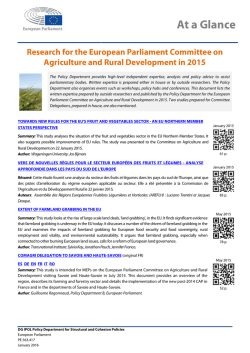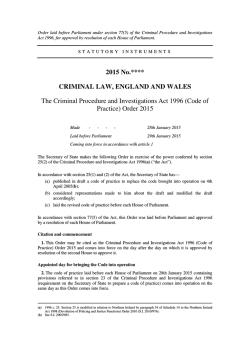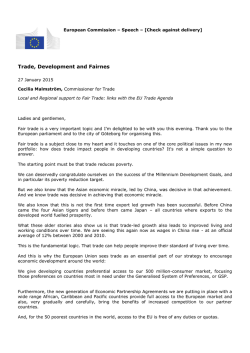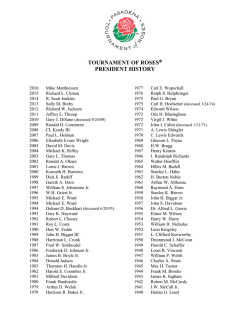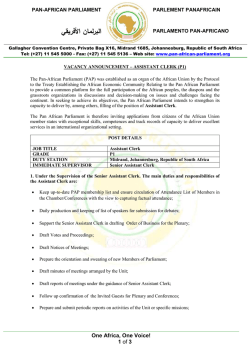
THE STUARTS - The World of Britain
THE STUARTS James I (1603-1625) After the death of Elizabeth I King James VI of Scotland ascended to the English throne as James I of England He seemed an excellent successor: • 20 years experience as the king ofScotland • A moderate Protestant, knowing how to deal with religious situation But his experience was good for Scotland: the English system of government, influenced by Parliament and the Church was very different On a personal level James was scholarly and intelligent, and especially enjoyed detailed theological debates. This interest may have encouraged his hatred and suspicion of witchcraft and bolstered his belief in the divine right of kings, which asserted that the sovereign had a God-given right to the throne and was the source of all laws. James's image was tarnished by his appearance and by his habits. He had thin rickety legs and a tongue which was too large for his mouth, which made him drink 'very uncomely' and slurred his speech. He gave strong indications that he was homosexual and was paranoid The Religious Matters At first James was content with the religious situation and raised hopes of both the Catholics and the Puritans. Acted as a mediator between the moderate of the Church of England and the more hard-line Puritans at the Hampton Court conference Personally organised the revision of the Bible (as suggested by the Puritans). The “Authorised Version” (1611) became the standard Bible in use. The title-page to the Authorised Version of the Bible, the new translation instigated by James I and published in 1611. This was to have an enduring impact wherever the English language and Anglican Church spread, until the second half of the twentieth century. Two prophets, Moses left and Aaron right, stand within the wall of the Old Testament which supports the four Evangelists above, behind whom stand the Apostles. At the top the radiance of the Tetragrammaton, the fourlettered Hebrew name of God, outshines both the sun and the moon. The Puritans – From 1564 – members of the Church of England who wished to eliminate Roman Catholic survivals in church ritual, or substitute a presbyterian for an episcopal form of church government. The Puritan theological position was essentially Calvinist and was associated with strict observance of the Sabbath, moral inflexibility and abstinance from pleasure. They were identified with the Parliamentary opposition under James I and Charles I During the conference James took a neutral line until the Puritans used the term 'presbyter' (meaning a church elder, not subject to a bishop) which he associated with the militant puritanism of Scotland. The conference quickly ended. The Puritans left. The king declared: 'I shall make them conform themselves, or I will harry them out of the land.' Groups of Puritans fled to Holland, but they were determined to establish their own communities. In 1620 a number of exiles, and Puritans from England, set sail from Plymouth in The Mayflower for the Americas. These pilgrim fathers founded the New England colonies. The Gunpowder Plot (1605) James reintroduced the Catholic penalties for not attending Church of England services, and several attempts were made against his life. The most serious was the Gunpowder Plot in 1605. A group of Catholic conspirators decided to kill the king, peers and MPs as they assembled for the opening of Parliament. A veiled warning was given to a nobleman in the Lords, who passed the message to the government. The cellars of the Houses of Parliament were searched and Guy Fawkes was caught red-handed with the explosives. The event is still remembered by bonfires and fireworks on 5 November. A Dutch view of the Gunpowder Plot. Above, the conspirators, depicted as country gentlemen, converse, while below they meet their savage fate. Several of the conspirators, including the most famous Guy Fawkes, were dragged from the Tower to Westminster, where they were hanged, drawn and Rex pacificus (the royal peacemaker) In his desire for peace and unity, he embarked on a plan to unify the laws of England and Scotland. He was unsuccessful, but from 1604 onwards he used the title king of Great Britain to signify the union of the kingdoms by one monarch. He wanted peace in Europe and brought the 15-year-old war with Spain to an end and sought to placate both Protestants and Catholics. In February 1613 James's daughter, Princess Elizabeth, married Frederick, the Elector Palatine of the Rhine, and James joined a Protestant union of European princes. The king that never was. James I's eldest son, Henry, died of typhoid fever in 1612. He was a young man of 18, of exceptional promise, with a passionate interest in the arts and a commitment to revive the vanished glories of the previous reign. His death was a tragedy. Here, attended by the Earl of Essex, he is about to slay the stag at his feet in a picture painted in 1603. Charles I, 1625-1649 Charles succeeded James in 1625, a year which has been seen as a turning-point in English history. The most obvious reason for this judgement lies in the new king's character. As a child Charles was shy and lonely - traits which remained with him all his life and were indicated by a stammer and a cold reserved manner. Within two months of succeeding to the throne, Charles I married Henrietta Maria, the French Princess. Marriage to the Catholic had not endeared him to an overwhelmingly Protestant Parliament Charles I with his queen, Henrietta Maria, and their two eldest children, the future Charles II at his father's knee and Princess Mary in her mother's arms. This huge picture was the first of the great series of portraits painted by the recently arrived court painter, Sir Anthony van Dyck, which were to immortalise the king and his court. Charles I dining in public at Whitehall Palace Relations with Parliament (1625-1629) Parliament had been summoned by Charles in 1625-6 and 1628-9. By 1629 the relations between King and Parliament had deteriorated The reasons for the breakdown in cooperation between Parliament and the king were numerous (his favorites f.ex.), but centred upon the raising of taxation and parliamentary rights. Charles dissolved and recalled Parliament several times RULE WITHOUT PARLIAMENT, 1629-1640 The House of Commons drew up a Petition of Right which emphasised the ancient rights of the people, and asserted that no man could be imprisoned without trial. With great reluctance Charles accepted it. Resentful at the Petition of Right and the rejoicing at Buckingham's death, he got determined to rule without Parliament. He did so for the next William Laud (1573-1645), The Archbishop of Canterbury The ideologist of Arminianism (Stressed the role of the sacramental and ceremonial aspects of the church service rather than the sermon and the scriptures) The general fear of Catholicism was reinforced by the activities of Catholics associated with the queen. Puritans, however, were harassed for being too Protestant; Laud urged bishops to inspect their bishoprics and punish anyone who did not conform. Many Puritans fled, thus increasing the numbers in the New England colonies. IRELAND From 1610 onwards an official policy of introducing Protestant 'plantations' into Ireland had been adopted. Land in the north of Ireland was divided up among wealthy City of London companies, and the new settlers (about 13,000 by 1622) were English or Scottish Protestants. The area of English political domination, called the Pale, centred around Dublin. Elsewhere Catholics still predominated. Thomas Wentworth (1593-1641) Became the Earl of Strafford In 1633 arrived in Ireland as Lord Deputy. He was highly successful at the court and, like Laud, was intimately involved with Charles's 'personal rule’ His ecclesiastical reforms, which imposed the Arminian ideas of Archbishop Laud, were particularly disliked in Ireland. The reasons for the Civil War The reasons for the English Civil War have been debated by historians for centuries: • the crown's disputes with Parliament; • the tensions between Puritans and the Church of England; • the locally organised resistance to the financial, religious and political policies of the crown; • and the increasing, capitalist prosperity of the gentry and merchants who challenged the privileges of the established nobility The pretext of the war. The “Short Parliament” Charles and Archbishop Laud attempted to impose religious uniformity upon Scotland via the English Prayer Book As a counter-measure the Scottish Presbyterians signed a National Covenant to 'recover the purity of the Gospel’ The two sides collected the armies so unevenly matching that Charles signed a peace treaty without a battle. In 1639 he recalled Parliament to vote him more money, but it refused until its grievances had been discussed; after a couple of weeks the 'Short Parliament' was dissolved. THE “LONG PARLIAMENT” Charles was now in serious financial difficulties. Parliament was recalled once again in 1640 Parliament greatly increased its own power • by making laws forbidding it to be dissolved without its own consent and • by suggesting that Parliament, and not the king, should control the army Two sides began to form Charles tried to arrest his five principal opponents and lost any support of MPs The Start of the Civil War(1642) At the beginning of the Civil War the support for each side split the country geographically. In broad terms the north, Midlands, Wales and the south-west supported the king, while the south, East Anglia and London supported Parliament. London contained a tenth of the entire population and had a large associated revenue with which to back Parliament. There were some notable exceptions to this broad division: Oxford and Cambridge supported the king, Bristol, Hull and Plymouth supported Parliament. Catholics, supporters of the Church of England, the aristocracy and their tenants tended to follow the king; Puritans, yeoman farmers and merchants tended to follow Parliament. The armies, too, had different characteristics. The Royalist army had a flamboyant image and excellent cavalry, hence their name 'Cavaliers'. The Parliamentarian army had an image of religious zeal, dour temperament and the belief that God was on their side; they supposedly got their name of 'Roundheads' from their short-cropped hair. Part of a musket drill as recorded by Henry Hexham in his The Principles of the Art Militanc published in 1637. Hexham was a soldier for over forty years. His book is a manual for the most up-to-date techniques of his day, those used in the Civil War. The frontispiece of a Royalist book describing early events in the Civil War. The New Model Army (1645) Largely the creation of Oliver Cromwell, it was a precursor of modern armies as it efficiently welded together a large number of troops. Professionalism was the key: discipline was strict - no swearing or gambling was allowed, training was thoroughly and the men could be trusted to obey orders in a crisis. Perhaps more importantly the soldiers were regularly paid in the later stages of the war the unpaid Royalist troops deserted in large numbers. A panoramic view of the battle of Naseby, 14 June 1645. The two armies face each other with the king alone on horseback in the centre The end of the Civil War (1646) After some hard fighting the Parliamentarian forces defeated the of Royalist army and the king's cause was all but lost. In 1646 Charles surrendered Being a prisoner he plotted and posed a threat to the Parliament After some hesitation a small “Rump” Parliament sentenced the king to death Oliver Cromwell and officers from the army expelling from Parliament any member opposed to their policies in November 1648. The ninety-six who remained were known as The Rump. Charles made no defence: he simply denied that the court had any validity. Some judges refused to try Charles on the basis that 'No court can try the King'. The death warrant of Charles I, signed by regicides On 30 January 1649 Charles I was executed in Whitehall. It was the first and only time that an English king had been tried by a court representing the people, found guilty and executed. An imaginary reconstruction of the execution of Charles I in 1649. Charles stepped out to the scaffold from the windows of the Banqueting House at Whitehall, and confronted death with courage and dignity. To many Puritans the Civil War and the execution of the king indicated that a perfect society was not only possible, but was imminent. It was believed that King Jesus would replace the old monarchy and a 'godly reformation' would transform society. Some foresaw that God would sooner or later shake all the Monarchies of the Earth', and others saw 'the kingdom of Jesus Christ begin to flourish, while the wicked . . . do now perish and fade like a blowne-offblossom'. This enthusiasm was not, of course, universal as many people were horrified by the execution of Charles and were fearful for their land and property. A balance was now needed between radical reforms and the stability required for local law and order. In the aftermath of the execution of the king extreme sects looked for the fruition of their beliefs. One such group, the Diggers, an offshoot of the Levellers, occupied land near Waltonon-Thames and began a colony in which all goods would be held in common. One of their traits, recorded here, was their refusal to doff their hats to their superiors. The Commonwealth (1649-1653) OLIVER CROMWELL Oliver Cromwell (1599-1658) a country gentleman from Huntingdonshire converted to puritanism at about 30. became an MP. during the Civil War commanded men from the eastern counties, had instigated the creation of the New Model Army, and had risen to be a lieutenant-general, second only in command to General Fairfax. then became a general and, after Fairfax's resignation in 1650, the leader of the army: an all-powerful post. Cromwell's character is remarkably difficult to assess. Some historians have seen him as an evil genius, whilst others emphasise his belief in democracy, 'godly rule' and toleration. At times he could be enlightened and a revolutionary idealist, and at others a pragmatist, carefully building up political alliances and weighing various factions. He was also caught between conflicting pressures: he tried to rule through Parliament, but gained his power from his leadership of the army, which included many radical Puritans. A contemporary painting of Oliver Cromwell The Protectorate, 1653-1658 After the execution of the king Britain became a republic called Commonwealth The Rump Parliament continued in power and in February 1649 the House of Lords and the monarchy were formally abolished, along with the Anglican Church The Rump Parliament appeared to be rather conservative in nature. The abolitions were not made effective In 1653 Cromwell dissolved Parliament and got the official title of Lord Protector The end of the Protectorate Cromwell instigated various reforms and his religious toleration was notable. Jews were allowed back into the country for the first time since the reign of Edward I, and new sects flourished, such as the Society of Friends (also known as Quakers) There was no state harassment concerning religion But the image of the joyless oppression instigated by some of the Puritan majorgenerals, through whom Cromwell ruled over the country, has too often coloured the tone of the Protectorate as a whole The Protectorate was loosing popularity Life under the Protectorate was shaped by the Puritans. Laws were passed against swearing, dancing, drinking, gambling and football. Theatres and inns were closed. No one was allowed to work on Sundays or go for a walk on the Sabbath.Even Christmas dinner was forbidden. Many people hated it. In 1657 Parliament nominated Cromwell's son, Richard Cromwell (1626-1712), as his successor The following year, on 3 September 1658, the Lord Protector died. Richard Cromwell quickly realised that he had not his father's genius and retired to his farm. After a year of confusion and generally indecisive government General Monck marched his army down from Scotland and assembled a Parliament. Charles was invited to become king and the Commonwealth and Protectorate came to an end. Charles II (1660-1685) After the execution of Charles I two campaigns were mounted by his son, Charles, to claim his inheritance Both were unsuccessful: first tie he was defeated by Cromwell in Scotland at Dunbar in 1650, second time - at Worcester. Charles was forced to flee and escaped to France, waiting for his time to return. Charles II arrived back in England in 1660 and was met by cheering crowds as he made his way to London On May 29 1660 Charles II made his entry into London, the climax of which was his reception by both Houses of Parliament in Whitehall Palace, the very building from whose windows his father had stepped to be executed in 1649. May 29 was the king's birthday; it was to be made into an annual national festival celebrating the restoration of the Monarchy . He was crowned on 23 April 1661 and was married to Catherine of Braganza, the daughter of the king of Portugal, in the same year. It is debatable whether he loved his convent-bred wife, but his mistresses and liaisons with other women were, and still are, legendary. In all Charles fathered at least fourteen illegitimate children, but produced no legitimate heir. Charles was essentially a cynic and pragmatist who was willing to change his beliefs for political advantage. He was also a man of wit, intelligence and charm, but he has been described as lazy and self-indulgent. He “never said a foolish thing, nor ever did a wise one” THE RESTORATION The most obvious point of the Restoration was that the monarchy was reestablished, though still limited by laws passed in previous reigns. Parliament was also restored on the old basis of two Houses, the Commons and the Lords. The power of the crown was limited by the Parliament: it could not enforce unparliamentary taxation, such as forced loans, nor could it arbitrarily arrest MPs The third restoration was of the Church of England and the bishoprics The most dramatic change came about with the restoration of the supremacy of the Anglican Church. After a strongly Royalist Parliament was elected in 1661, action was taken against those who were Protestant but not Anglican. These people, grouped together under the term 'nonconformists', included Baptists, Congregationalists and Quakers. The measures, known as the Clarendon Code, were aimed at diminishing the potential influence of the nonconformists; they were silenced by laws • requiring them to agree with every word of the Book of Common Prayer • and forbidding them to hold a government office or go to university THREE GREAT DISASTERS: the return of the bubonic plague in 1665 • the last great outbreak that hit London especially hard; the city was brought to a standstill and tens of thousands died. Carts carrying the dead were wheeled through the dark, insanitary streets and crosses were painted on the doors of the houses where people had died. In 1666 a fire of London started • in a baker's shop in Pudding Lane and rapidly spread through London's closely-packed wooden buildings. The fire raged for three days; in some places the ground was too hot to walk upon for two weeks afterwards. Rebuilding started quickly, with an order from the king that buildings should be built of brick. In 1665 the Second Dutch War had started, and by 1667 the king's finances were so depleted that he ordered the English fleet to be laid up in the Medway at the mouth of the Thames. Samuel Pepys (1633-1703) one of the greatest of English diarists, he recorded the events in graphic detail. His diaries make compelling reading and give a wonderful insight into the times. Sir Christopher Wren (1632-1723) Christopher Wren rose to prominence as a surveyor and architect: his masterpiece, the new St Paul's Cathedral, rose phoenix-like from the ashes and was a marvel of its age with its high-spirited and dramatic classical style. Sir Christopher Wren, with his most important achievement, St Paul’s Cathedral, in the background ANTI-CATHOLICISM AND CATHOLICISM Between 1668 and 1681 religion was at the forefront of politics Charles antagonised many Anglicans and Protestants by his support of Catholicism and by treaties with the French king Louis XIV Parliament agreed with the Anti-Catholic mood of the people and excluded the rightful heir, James, Duke of York, from the throne because he was Catholic. The 'Exclusion Crisis' over James's right to succeed to the throne focused attention upon two groups of MPs: Those who supported James tended to be Anglicans and were nicknamed 'Tories' after Catholic outlaws in Ireland. In opposition were the 'Whigs', so called after the Whiggamores who were fiercely Protestant Scottish drovers. The Whigs supported the claim of Charles's illegitimate son, the Protestant Duke of Monmouth. (the Whigs later plotted to kill Charles and James, were executed and the rights of James were resumed) The Glorious Revolution William decided to accept the invitation His tactics were to state that • he wanted to protect Protestant rights rather than bidding directly for the crown • and to avoid a civil war by not provoking full-scale battles William defeated James (who fled, was captured and allowed to escape to France) without a battle Uniquely in English history Parliament agreed to recognise William and Mary as joint sovereigns In return the new monarchs had to accept a Bill of Rights, which established the supremacy of Parliament over the monarchy. William of Orange landing at Torbay on November5th, 1688. A 19th-ctnture picture of Queen Anne, daughter of James II, and the Kings of the Garter. THE UNION OF ENGLAND AND SCOTLAND The most important measure to be passed by Parliament during Anne's reign was the political union of England and Scotland Scotland kept its own church and law courts but would be represented in the London Parliament and have equal trading rights with England. In 1707 the last Scottish Parliament assembled and on 1 May 1707 the 'United Kingdom of Great Britain' came into existence. THE ARTS In the arts the trend under the Stuarts was towards the secular and rational, with considerable influence from classicism: the works of architects Inigo Jones and Sir Christopher Wren, and painters Rubens and van Dyke Drama declined from the height of Shakespearean tragedy The greatest literature was religious (John Bunyan, The Pilgrim’s Progress; John Milton, Paradise Lost) The ceiling of the Banqueting House at Whitehall painted by Rubens in Antwerp. The centre panel is The Apotheosis of James I. Van Dyck's painting of the Earl of Pembroke and his family, at Wilton House. Van Dyck was court painter under Charles II and executed many portraits of the king and his family. The architect and designer Inigo Jones introduced the complete classical style from Italy into England. The Queen's house at Greenwich exhibits the perfection of his style. THE SCIENCES One of the most lasting influences came from secular thought. Francis Bacon's (1561-1626) emphasis upon experimental science inspired the foundation of the Royal Society in 1662. The Society became the focus for scientific debate and attracted a wide range of scientists, including the chemist Robert Boyle (1627-91) and later the astronomer Edmund Halley (1656—1742). King Charles himself took a keen interest in the Society and founded the Royal Observatory at Greenwich in 1675: The second half of the century was dominated by two giants of the intellect, both of whom had powerful secularising effects: John Locke (1632-1704), whose theories of the mind laid the foundation for ‘modern’ thought Isaak Newton(1642-1727), whose explanation of physics founded the modern understanding and exploration of the universe
© Copyright 2025
